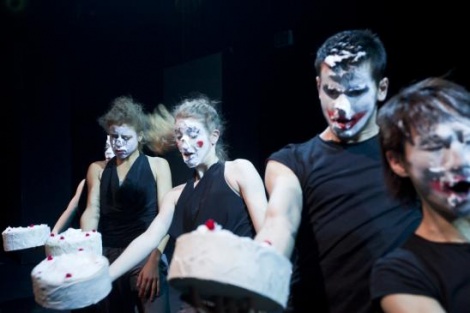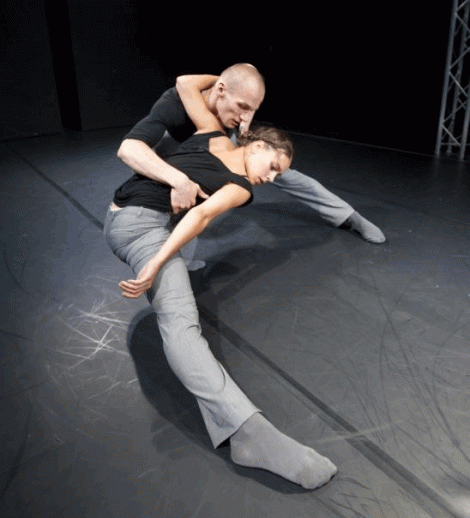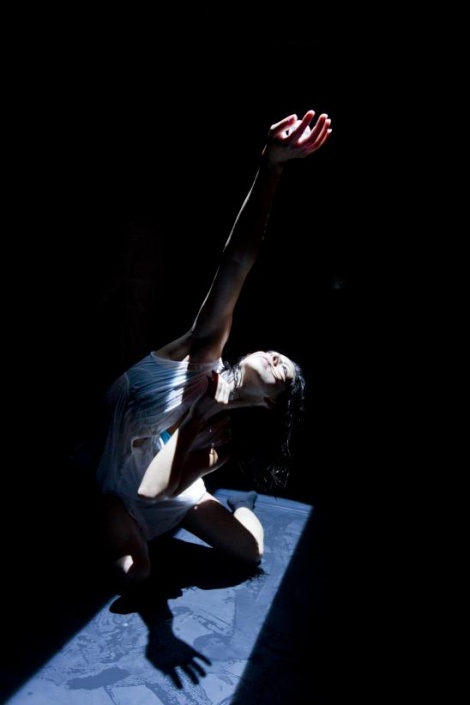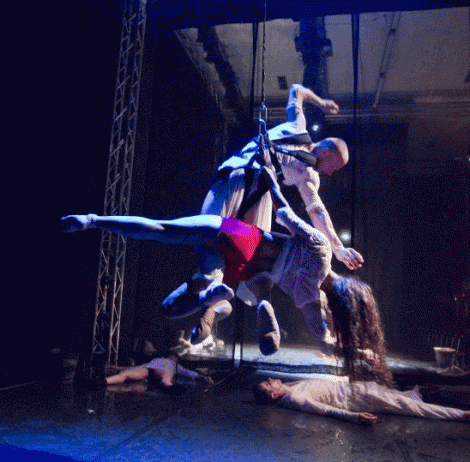For the final Oper Graz dance work in June, ballet director Darell Toulon brought two promising choreographers to Graz to create new works.
The lucky pair: Vienna’s budding star Nikolaus Adler lately of Homunculus and Villach born Guido Markowitsch, best known for his choreography for musicals and his work in Darmstadt Staatstheater.
While both pieces were part of a coherent evening, as separate and nearly full length works, I have divided this review into two sections.
Resurrection or the Alienation of Humanity – Nikolaus Adler
At first glance Resurrection appears to be a reprise of Törte für Alle, which premiered at Choreolab in 2006. Adler has brough back the cakes, the clowns, the brutal music from the Tiger lillies, a statue of the Virgin Mary next to a dead man and even a little girl singing a beautiful song at the end.
But in fact Resurrection is more a complete remake of the original with a little more time and a dedicated cast. The last piece was created at Choreolab where the dancers are just borrowed from Staatsoper between rehearsals for the main stage. Very happily Adler has made some of the explicity intellectual pretensions of Torte fur Alle (billboard style references to Sartre and Fox news) implicit and reinvested the returns in the dancing.

Nikolaus Adler – Resurrection oder die Befremdlichkeit
der Zwischen Menschlikeit: Cakes and Clowns again
Resurrection opens very strongly with high speed deep bending dancing with grinding rhythms. The opposite of what one could expect from the usually austere Adler. What is remarkable about his choreography are the contrasts. Even during a powerful energetic duet, Adler will stop to show delicate work with fingers. Without being afraid of movement, Adler has always shown an unusual fineness of gesture.
I’ve always wondered how and why Toulon chooses his performers for Oper Graz. His auditions go on for weeks and in the end, he usually chooses not particularly tall nor superficially attractive dancers in what is frankly a buyer’s market. Now I’ve found out:
Opera Graz dancers can really move. Particularly astonishing are Laura Fischer, Michael Munoz and Bostjan Ivanjsic.

Bostjan Ivanjsic Laura Fischer duet Resurrection:
wonderful movement and powerful duets based on contact
After the opening burst of energy, Resurrection quickly slows down to Adler’s usual ironic sadness: Adler’s macabre clowns stand in a line and push a cake in one another’s faces.
Adler takes us through a sinister pantomime of funeral by a group of clowns, complete with statue of Virgin Mary by the head of the deceased. Adler’s clown-faced brutes kick the poor corpse in the head. Wtih all the cellars in contemporary Austria filled with the corpses of unwanted lovers and incest’s children, Adler’s wanton brutality seems part of daily life here in Austria.
The pace doesn’t relent with a spectacular duet between Ivanjsic and Fischer without music: swinging arms writ large, difficult lifts and kinetic gyration. Stunning dancing: mesmerising enough to only notice the absence of music when sound reappears in the next duet.
Adler was able to go to complex, dangerous movement with these dancers experienced with one another and with enough rehearsal time. Much of the movement seemed polished versions of very good contact improv. Contact improv is about communication with the partner so refining it for the stage is to choose communication through movement.
All good things must come to an end and they do with a little girl on stage with another dancer. Tatjana Wiesenhofer sang extremely beautifully:
My papa was a wonderful clown. My father was a beautiful man.
All children are charming on stage. Wiesenhofer has a great voice and seems a natural.
Sometimes it is not nice to be me – Guido Markowitz
The simple narrow black stage was divided into three with two ten metre silk like transparent black curtains. Two men begin the action with an extended duet. Neither Mathias Strahm nor Gyorgy Baán much impress. Their movements are exaggerated and false, parodic. Not nearly so fine as the work Adler just showed us. The tall Strahm reminds one of typically world weary Nicolas Cage.
Happily enough the next duet between Michael Munoz and Shaohui Yi brought some real intensity back to the stage. Munoz seems to woo Yi to no avail. Yi’s persistent rejection is relentless. Munoz’s grimace of fury sears us.
On the curtains, water drops are cleverly projected. I’m as tired of projection as the next contemporary theatre-goer: most projection is mainly a worn out trope but here the moving drops felt real and right. Sounds of rain and water justified the visual. Stagecraft which works and is not expensive: you can see that Markowitz worked hard to bring light, sound and texture together to support the water theme.
Occasionally the antics to extend the water metaphor consume art, leaving only device: the dance with a full glass of water trying not to spill it was either pretentious or something from reality TV.
But then suddenly an astonishing solo from Dianne Gray stroking her own body with handfulls of ice offers a breathtaking visual and moves us with its strong emotional text.

Dianne Gray’s exceptional solo with ice cubes in her hands
Action now takes place in all three stages, with two sets of action on the left. The drama in the center, solos and duets on the sides while Munoz still weeps as the Japanese ex-girlfriend slaps him around. The effect is symphonic.
On both sides, there are ice solos while in the middle a trio dance: Michal Zabavik and Ivansjic with Fischer between them. The two men beat each other senseless for Fischer’s favours. The scene ends with Michal Zabavik drowning Ivansjic. Ivansjic’s head is held under water several times for up to as long as a minute. Even two of the girls come in to help hold a struggling Ivansjic upside down. When Ivansjic’s comes out of the water wet and gasping, it is not play acting.
The music splinters between klang effects, the crash of ice against metal (live) and vocal lullabies. The contrast makes each more effective in turn. The two men fighting on a wet floor means real danger, a sort of Ultima Vez light (Wim Vandekeybus’s company will likely hold the record for the highest career threatening injury per dancer forever).
Now six of the girls lie on stage and gargle together, extending the water metaphor to undreamt extremes. Ivansjic is strapped by the men into a trapeze on the left. As he hanges there helpless, Fischer comes and dances the most astonishing passion with him.
At times she climbs up onto Ivansjic to embrace him. At times Fischer is on the floor and Ivansjic pulls her limbs up to him as she somersaults or hangs upside down in his arms. Fischer’s long tresses cascade in the light, shiny and feminine and beautiful. They kiss kisses of passion. Finally Fischer rides Ivansjic like a broken horse.

Bostjan Ivanjsic & Laura Fischer on and off the trapeze together
one of the best duets I’ve ever seen: perfect conception
with touching performances from both dancers
For the last ten minutes into the golden age of Rosas and Ultima Vez. We don’t often see dancing or choreography as raw and passionate as what Ivansjic and Fischer have just shown us. The duet is like all of Romeo and Juliet distilled to seven minutes.
Michael Munoz is still to go mad, spat on from all sides by seven comrades or ex-lovers. The ice crashes louder and louder. In the end, he slaps his own leg out from under himself in an amazing acrobatic and symbolic fall. Like Munoz, sooner or later we all slap a leg out from under ourselves. It is only human.
Still, Sometimes it is not nice to be me piece slowly disintegrates after the trapeze duet. There is nothing Markowitz or frankly nearly any other choreographer can offer to maintain the intensity after such a moment. Perhaps the piece should have gone out on a high. Perhaps it’s better that it winds down with a slow thud. The last performers are not nearly as interesting as Munoz, Ivansjic, Fischer, Yi and Dianne Gray.
Envoi
A spectacularly successful evening on a very small and narrow stage. Markowitz, Adler and Toulon demonstrate you need neither large stage nor large budget to mount ambitious work. A will to create, strong dancers and the time to do it (rehearsals were spaced out over months and the premier date was moved a month later) are all it takes.
If you are tired of the Vienna silent non-movement conceptual scene, if you still love dance, if you’d like to see passionate movement, get thee hence to Graz while you still can. Jump Start is not an evening to be missed.
There are Jump Start performances on Tuesday 21 June, Wednesday 22 June, Saturday 25 June, Sunday 26 June. Keep in mind the performances are not in Oper Graz but StudioBuhne Wilder Mann Jakomimistraße 3-5 about ten minutes walk from the Opera. Photos © Werner Kmetisch/Oper Graz: frankly both shows are much more exciting than the photos show.


[…] piece as electric as the Guido Markowitz’s “ Sometimes it is not nice to be me” from last year. Part of the issue may be the absence due to injury of Bostjan Ivanjsic, the […]